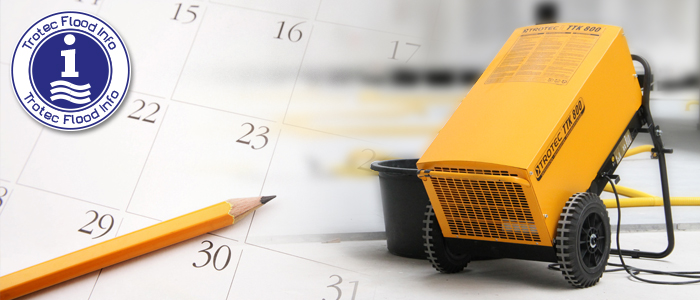
It is very important to make a fast dehumidification because the longer it takes the higher is the possibility that consequential damages appear. How long a dehumidification takes depends on the choice of the drying unit. Another important point is the place where the dehumidifier is set up.
We want to point out that in the current situation regarding to the floods in Southern and Eastern Germany as well as in Austria, Switzerland and the Czech Republic the ideal drying unit is not always available. Using another device is not wrong the work just can take a bit longer.
The right device output as well as the dehumidification performance are the basic requirements for a quick drying process. When the dehumidifier is too small it, necessarily, takes longer but a too powerful condensation dryer, as well, can slow down the drying. For sure, that sounds absurd but to understand that we first have to explain the transport process of the water through the structural component like a wall.
Water can be transported through a wall very quickly when it is in liquid form in the capillaries of the material. Via the capillaries it is transported to the wall surface where it evaporates but the capillaries can only transport a certain amount of water in a certain time. Thus, a too big dehumidifier dries more water than there is available on the surface of the wall and the water not only evaporates on the surface but in the wall as well where it turns from liquid into gas what needs much more time to get to the surface.
Find the ideal dryer for your purposes in the list in this article.
You have two different alternatives to position the dehumidifier.
- Ideally, you have a condensation or adsorption dryer for each room what makes the dehumidification very easy because you just position a dryer in the middle of every room.
- You don’t have a dryer for every single room? Then the air exchange between the rooms is important. If possible, put a fan in those rooms where no dehumidifier is. Position it in a way that the air flows through the room diagonally towards the open door. When you don’t have enough fans, too, change the rooms after two or three days and reposition the drying units.
The optimal conditions for the dehumidification
With room temperatures between 15 °C and 25 °C the rooms will dry best because the warmer the air is the more water it can absorb. When it is colder than 15 °C a heater noticeable quickens the dehumidification process. Furthermore, under 10 °C to 15 °C the dehumidification performance of condensation dryers decreases. More and more ice forms in the device and it more often makes defrost pauses what leads to a drying delay.
The last point to mention is the ventilation because that is an often underestimated fact. But it is undisputable that optimal ventilation can even halve the drying duration.
With other words: In the ideal situation, put a fan in every room, too. Read more about that topic in this article.
Trotec Flood Info: To inform you in any case of damage
We inform you about the following topics in detail:
- Trotec assists flood victims with expertise
- How long does a dehumidification take?
- Should I rent or buy a drying unit?
- Trotec Flood Info: The right moisture measurement after flood damages
- Trotec Flood Info: When do I need an expert?
- Trotec Flood Info: What to do when mould attacks?
- Trotec Flood Info: How to dry floor insulations
- Trotec Flood Info: What to do against the smell after the flood damage?
- Trotec Flood Info: The main facts about drying units

